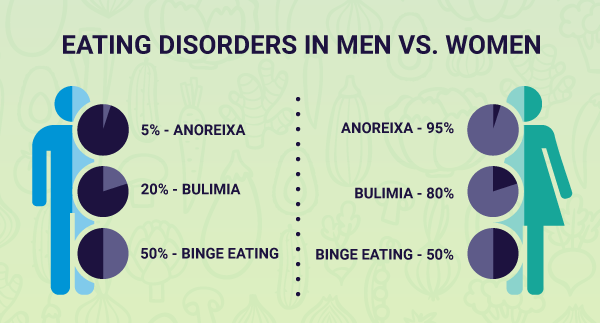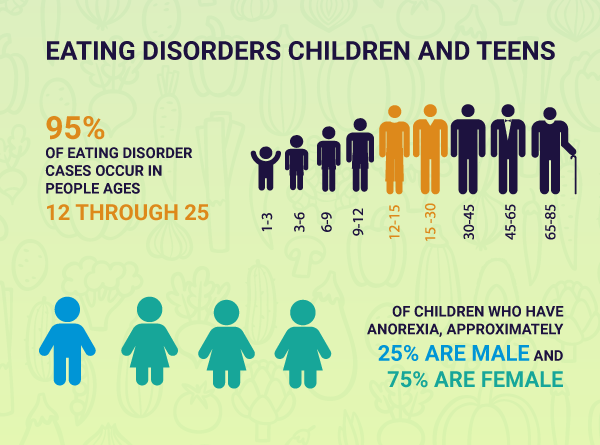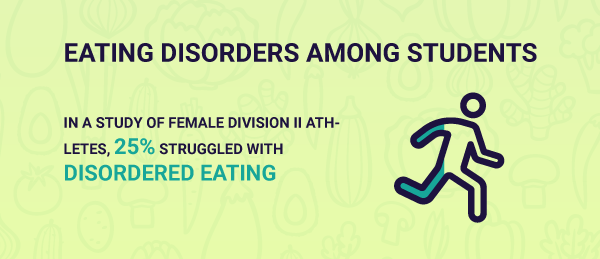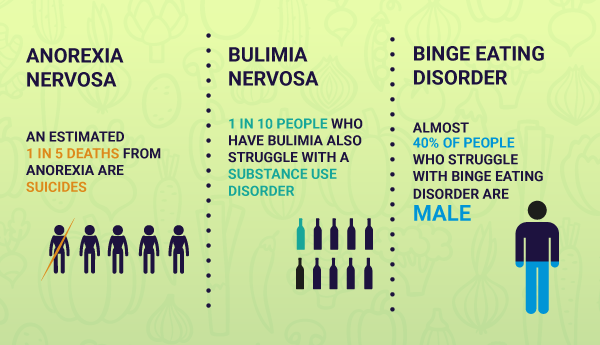Eating disorder statistics show that anorexia nervosa, bulimia nervosa, binge eating disorder and other eating disorders affect thousands of Americans each year.
For the public to have an accurate understanding of eating disorder statistics, clinical studies must be conducted often to assess the prevalence of eating disorders in changing populations. This page aims to depict the current state of eating disorders in America using the most accurate eating disorder facts and statistics available. As eating disorder research continues to develop, the information listed on this page may change.
Prevalence of Eating Disorders
Approximately 30 million Americans struggle with eating disorders. At least one person dies from an eating disorder every 62 minutes in America. Eating disorders can affect anyone regardless of gender, age, ethnicity or culture. There are many different types of eating disorders. Some of the most common in America are anorexia nervosa, bulimia nervosa and binge eating disorder.
According to the National Institute of Mental Health, the lifetime prevalence rates of eating disorders in Americans ages 18 and older include:
- Binge eating disorder: 2.8 percent of American adults.
- Bulimia nervosa: 1 percent of American adults.
- Anorexia nervosa: 0.6 percent of American adults.
Except for anorexia being disproportionately high among non-Hispanic Caucasians, the prevalence of eating disorders across the United States is similar among the Hispanic, non-Hispanic Caucasian, African-American and Asian populations. Regardless of demographic, the high rate of eating disorders in America means that reliable, effective treatment options are necessary.
Eating Disorders in Women
According to the National Institute of Mental Health, eating disorders are more prevalent among women than men. Approximately 20 million American women experience eating disorders at some point in their lives.
Statistics from the Substance Abuse and Mental Health Services Administration (SAMHSA) reveal that some of the most common eating disorders in women include:
- Anorexia nervosa: Up to 95 percent of people who have anorexia are female.
- Bulimia nervosa: Approximately 80 percent of people with bulimia are women.
- Binge eating disorder: Rates of binge eating disorder are approximately the same among men and women.
Eating Disorders in Men
Although American women struggle with eating disorders more frequently than men do, men also face eating disorders. Approximately 10 million American men will experience eating disorders during their lifetimes, according to data from Mental Health America.
Eating disorders in men may stem from a variety of issues, including:
- Excessive, or unsafe, dieting
- Disordered eating habits
- Muscle dysmorphia, an obsession with becoming more muscular
- Body dysmorphic disorder (body dysmorphia), a mental health condition associated with perceived physical flaws
Unfortunately, it is widely believed that men rarely develop eating disorders. This belief can lead to a later diagnosis from medical professionals and can increase the risk of death associated with these disorders among men.

Eating Disorders in Children and Teens
Many children and teenagers struggle with eating disorders like anorexia and bulimia. Eating disorders in children and teens can stem from a variety of issues, including body image and peer pressure.
In America, statistics on the current prevalence of eating disorders in teens, adolescents and children include:
- Approximately 95 percent of eating disorder cases occur in people ages 12 through 25
- One study of 14- and 15-year-old teens revealed that dieting was the leading predictor of the development of eating disorders
- Among adolescent girls, eating disorders are the third most common chronic health condition
- Approximately 25 percent of children who have anorexia are male
- Up to 2 percent of adolescents and young adults struggle with bulimia
- Fewer than 1 in 5 adolescents who have eating disorders receive treatment

Eating Disorders Among Students
Amidst the stress of school, peers and social media, many students struggle to maintain a healthy body image and eating habits. The pressure to be thin or to strive to achieve the ideal body type causes some students to develop eating disorders.
Current statistics on eating disorders in college students and among high school students include:
- An estimated 11 percent of high school students were diagnosed with an eating disorder, according to a 10-year study by the National Association of Anorexia Nervosa and Associated Disorders
- According to the National Eating Disorders Association, eating disorders typically develop between the ages of 18 and 21. Many college students are between these ages.
- A 2015 survey of college students reported that transgender students were more likely to report being diagnosed with eating disorders than any other student demographic
- A national study of colleges found that among sexual minority students, 3.5 percent of women and 2.1 percent of men struggled with eating disorders
- One study of more than 2,000 university students found that 3.6 percent of male students had positive screenings for eating disorders
- Among college-aged women, up to 19 percent struggle with bulimia

Eating Disorders Among Athletes
Athletes are under enormous pressure to perform well and be physically in shape. However, this pressure can lead to disordered eating habits and the development of eating disorders.
Available data on the prevalence of eating disorders in athletes include:
- A study cited by the National Eating Disorders Association reported that more than one-third of female Division 1 NCAA athletes held attitudes and symptoms of anorexia nervosa
- In a study of female Division II athletes, 25 percent struggled with disordered eating
- Of athletes in weight-class and aesthetic sports, approximately 33 percent of men and 62 percent of women struggle with disordered eating
- One multi-university study of 204 female collegiate athletes in 17 different sports reported that 2 percent had an eating disorder and more than 25 percent exhibited eating disorder symptoms
Anorexia Nervosa Statistics
People who have anorexia nervosa see themselves as overweight, even when they are underweight, and limit their food intake severely. The anorexia facts are simple, yet alarming: it is a debilitating mental health condition that can be deadly.
Anorexia nervosa statistics in America reveal the sad reality of this condition and the need for reliable treatment options. Current anorexia statistics include:
- Almost 1 percent of American women will face anorexia during their lifetime
- Of people who have anorexia, 25 percent are male
- At any given time, approximately 0.1 percent of young American men will struggle with anorexia
- Of all mental health disorders, anorexia has the highest mortality rate
- People who have anorexia face a mortality rate 18 times higher than their peers who do not struggle with eating disorders
- An estimated 1 in 5 deaths from anorexia are suicides
Bulimia Nervosa Statistics
Bulimia nervosa is an eating disorder that involves binge eating and purging behaviors to compensate for overeating. Bulimia nervosa statistics are startling, especially in America, but treatment options are available.
Existing research on bulimia facts and currently available bulimia statistics include:
- Bulimia is five times more common in women than men
- Approximately 1.5 percent of American women will struggle with bulimia during their lifetimes
- In America at any given time, approximately 0.1 percent of young men and 1 percent of young women meet the criteria for bulimia
- More than half of all people who have bulimia struggle with a co-occurring anxiety disorder
- Approximately 1 in 10 people who have bulimia also struggle with a substance use disorder like alcoholism
Binge Eating Disorder Statistics
People who struggle with binge eating disorder struggle with recurring episodes of binge eating. Binge eating facts reveal that people who have this condition often use compensatory measures after they eat, and struggle with feelings of shame and guilt.
Current binge eating disorder statistics in America show that this condition is both widespread and deadly, and deserves immediate treatment. Existing binge eating statistics include:
- In the United States, binge eating disorder is the most common type of eating disorder
- In America, binge eating disorder is more common than HIV, breast cancer and schizophrenia
- An estimated 2.8 percent of Americans will face binge eating disorder at some point in their lives
- In America, binge eating disorder is three times more prevalent than bulimia and anorexia combined
- Almost 40 percent of people who struggle with binge eating disorder are male

OSFED Statistics
Eating disorders that do not meet the diagnostic criteria for anorexia or bulimia are considered Other Specified Feeding or Eating Disorder (OSFED), according to the Diagnostic and Statistical Manual of Mental Disorders, 5th edition. The acronym OSFED replaced Eating Disorder Not Otherwise Specified (EDNOS).
Data and OSFED facts reveal that although OSFED is different from other eating disorders, they are just as serious. Existing OSFED statistics include:
- The standard mortality rate among people with OSFED is estimated to be 1.9 percent, according to an analysis of 36 eating disorder studies
- A study conducted with nearly 2,000 eating disorder patients at the University of Minnesota found that the mortality rate of EDNOS (now OSFED) was 5.2 percent. This figure was higher than the observed mortality rates of anorexia (4 percent) and bulimia (3.9 percent).
- Approximately 1 in 10 OSFED patients has a co-occurring substance abuse issue
Body Image and Dieting
Body image issues, dieting and eating disorders are often deeply intertwined. An unhealthy body image can be fueled by many different factors, including social media sites like Facebook that perpetuate socially defined standards for ideal, yet often unrealistic, physiques. Issues with body image can stem from serious conditions like body dysmorphic disorder and can lead to eating disorders that involve unsafe dieting.
Dieting may be symptomatic of many different types of eating disorders. According to the National Eating Disorders Association, a history of dieting is a prominent risk factor for eating disorders. Dieting statistics in America include:
- The most significant behavior that leads to eating disorders is dieting, according to the American Anorexia and Bulimia Association, Inc.
- According to the Washington Post, 45 million Americans diet annually
- A study cited by the National Eating Disorders Association found that of people who diet, 35 percent progress to pathological dieting. Of this 35 percent, up to 25 percent develop eating disorders.
- Research cited by Time Magazine found that among people who are obese and lose weight (including by dieting), 80 percent gradually regain the weight they’ve lost
- In a clinical study of people who are overweight, motivation to lose weight declined from 56 percent in 1990 to 49 percent in 2014. This data comes from a 26-year study published in the Journal of the American Medical Association.
Statistics on Eating Disorder Recovery
Because research on the progression of eating disorders is developing, limited, and sometimes unreliable, data exists on eating disorder recovery statistics. Further research is needed to assess recovery from eating disorders. However, one point is clear: eating disorders are treatable and recovery is possible.
Currently available statistics on long-term recovery from eating disorders include:
- Approximately one in 10 Americans who have eating disorders get treatment
- Sixty percent of people who struggle with eating disorders recover through treatment
- About 80 percent of women who enroll in treatment for eating disorders do not receive sufficient care to help them recover
- Approximately 20 percent of people who have eating disorders and enroll in treatment make partial recoveries
How to Get Help for an Eating Disorder
If you or someone you know struggles with an eating disorder, treatment is available. For immediate assistance, or help in evaluating your options, you can:
- Call the National Eating Disorders Association hotline at (800) 931-2237
- Text the National Eating Disorders Association acronym “NEDA” to 741741 to instantly connect with a trained crisis counselor on the Crisis Text Line or click to chat.
- Use the SAMHSA behavioral health treatment locator and filter the results by zip code, types of treatment and practicing medical professionals
Related Topic: Starting Teletherapy for Addiction & Mental Health

American Psychological Association. “Eating Disorders.” Last updated October 2011. Accessed December 21, 2018.
Anorexia Nervosa & Related Eating Disorders. “Statistics: How Many People Have Eating Disorders?” Accessed December 21, 2018.
Aubrey, Allison. “Skinny Isn’t All That: Survey Finds Fe[…]n Women Are Dieting.” National Public Radio, Inc., published January 7, 2013. Accessed December 21, 2018.
Aubrey, Allison. “Is Dieting Passe? Study Finds Fewer Over[…] Try To Lose Weight.” National Public Radio, Inc., published March 8, 2017. Accessed December 21, 2018.
Journal of the American Medical Association. “Change in Percentages of Adults With Ove[…]e Weight, 1988-2014.” Published March 7, 2017. Accessed December 21, 2018.
Mental Health America. “Eating Disorders.” Accessed December 21, 2018.
National Association of Anorexia Nervosa and Associated Disorders. “Eating Disorder Statistics.” Accessed December 21, 2018.
National Eating Disorders Association. “Eating Disorders & Athletes.” Accessed December 21, 2018.
National Eating Disorders Association. “Eating Disorders & Athletes (PDF)” Accessed December 21, 2018.
National Eating Disorders Association. “Eating Disorders on the College Campus.” Accessed December 21, 2018.
National Eating Disorders Association. “Other Specified Feeding or Eating Disorder.” Accessed December 21, 2018.
National Eating Disorders Association. “Risk Factors.” Accessed December 21, 2018.
National Eating Disorders Association. “Statistics & Research On Eating Disorders.” Accessed December 21, 2018.
National Institute of Mental Health. “Eating Disorders: Overview.” Last updated February 2016. Accessed December 21, 2018.
National Institute of Mental Health. “Statistics: Eating Disorders.” Last updated November 2017. Accessed December 21, 2018.
Roepe, Lisa Rabasca. “The Diet Industry.” Sage Business Researcher, published March 5, 2018. Accessed December 21, 2018.
Searing, Linda. “The Big Number: 45 million Americans go on a diet each year.” The Washington Post, published January 1, 2018. Accessed December 21, 2018.
Sifferlin, Alexandra. “The Weight Loss Trap: Why Your Diet Isn’t Working.” Time Magazine, published May 25, 2017. Accessed December 21, 2018.
South Carolina Department of Mental Health. “Eating Disorder Statistics.” Accessed December 21, 2018.
Substance Abuse and Mental Health Services Administration. “Eating Disorders.” Last updated May 2017. Accessed December 21, 2018.
The Alliance for Eating Disorders Awareness. “Eating Disorders Statistics.” Accessed December 21, 2018.
The Recovery Village aims to improve the quality of life for people struggling with substance use or mental health disorder with fact-based content about the nature of behavioral health conditions, treatment options and their related outcomes. We publish material that is researched, cited, edited and reviewed by licensed medical professionals. The information we provide is not intended to be a substitute for professional medical advice, diagnosis or treatment. It should not be used in place of the advice of your physician or other qualified healthcare providers.